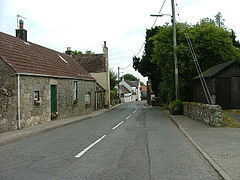Scotlandwell
| Scotlandwell | |
|---|---|
 Scotlandwell |
|
| Scotlandwell shown within Perth and Kinross | |
| OS grid reference | NO186016 |
| Council area | |
| Lieutenancy area | |
| Country | Scotland |
| Sovereign state | United Kingdom |
| Post town | KINROSS |
| Postcode district | KY13 |
| Dialling code | 01592 |
| Police | Scottish |
| Fire | Scottish |
| Ambulance | Scottish |
| EU Parliament | Scotland |
| UK Parliament | |
| Scottish Parliament | |
Scotlandwell is a village in Portmoak, Perth and Kinross, Scotland. It lies to the east of Loch Leven, at the junction of the A977 and B920 roads, approximately 4 miles west of Glenrothes and 4 miles east of Kinross.
The main historical features of Scotlandwell village are The Well & Wash House
Scotlandwell is one of the great historic sites of Kinross-shire. Named Fons Scotiae by the Romans who passed this way nearly 2,000 years ago, the curative waters that bubble up through the sandy ground were used by Red Friars who maintained a hospital in the village between 1250 and 1587.
Thousands of pilgrims came to Scotlandwell to take the water, the most famous perhaps being King Robert the Bruce who is alleged to have found a cure for leprosy here.
The people of Scotlandwell are rightly concerned about the state of the historic well and nearby washhouse, which are both urgently in need of upkeep and repair. While the well itself needs a good clean out and minor structural attention, the washhouse is an architectural gem that is fast deteriorating.
With a view to rescuing the washhouse and putting it to some use Portmoak Community Council has approached the District Council, which fell heir to these unusual buildings in the 1920s.
The building of the ornamental well and wash house in Scotlandwell in more recent times was undertaken as part of a general scheme of village improvement carried out between 1857 and 1860 by Thomas Bruce of Arnot.
A direct descendant of Sir William Bruce, the architect of Kinross House, Thomas Bruce was the feudal superior of the old Barony of Arnot which included the village of Scotlandwell as its principal settlement.
In 1822 a small piece of common ground, situated by the main street and known locally as the Peat Hill, was divided up amongst the feuars of the village. Thomas Bruce of Arnot, who eventually acquired all of this land, decided to beautify the village by landscaping the site where the villagers of Scotlandwell had formerly stacked their peat.
The spot where the well now stands was then described as being "an almost unapproachable slough of mire and filth" beside which stood "a half ruinous building used sometimes as a washing house and sometimes as a slaughter house."
In March 1857 the plan for an ornamental fountain or well was prepared by the distinguished Edinburgh architect David Bryce (1803–76). Best known for his large-scale "Scottish Baronial" buildings, which include Fettes College and the Royal Infirmary in Edinburgh, Bryce designed not only the well but also the stylish washhouse opposite. Using stone from quarries at Greenhead of Arnot and Nivingston near Cleish, the well was completed in 1858 at a cost of GBP154.
...
Wikipedia

